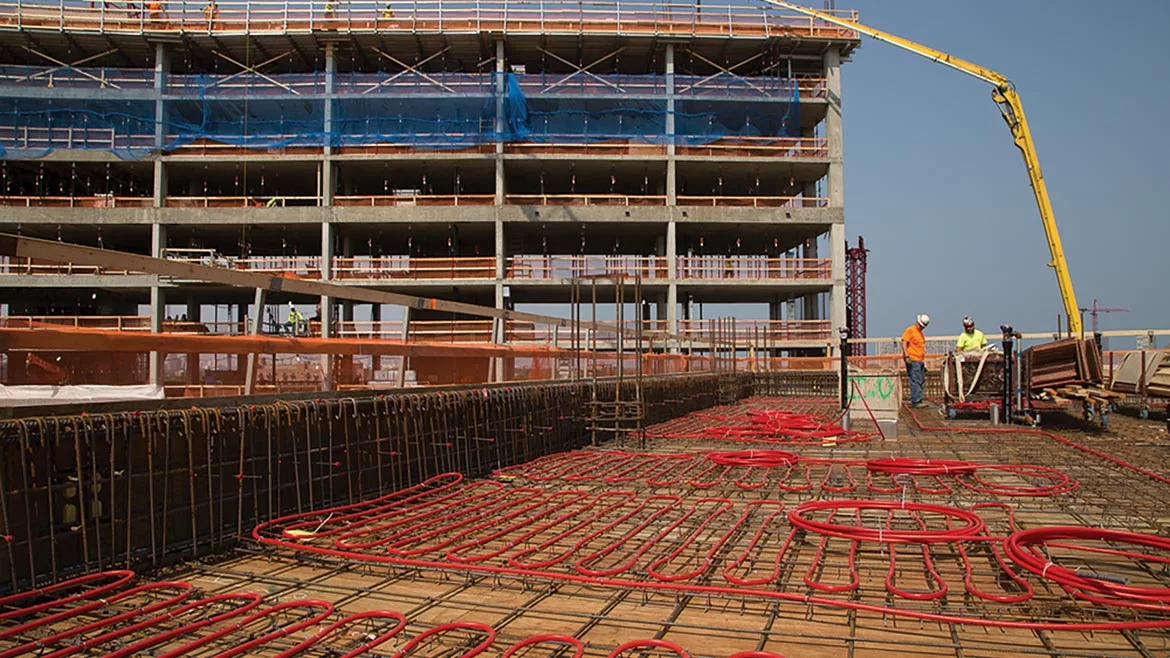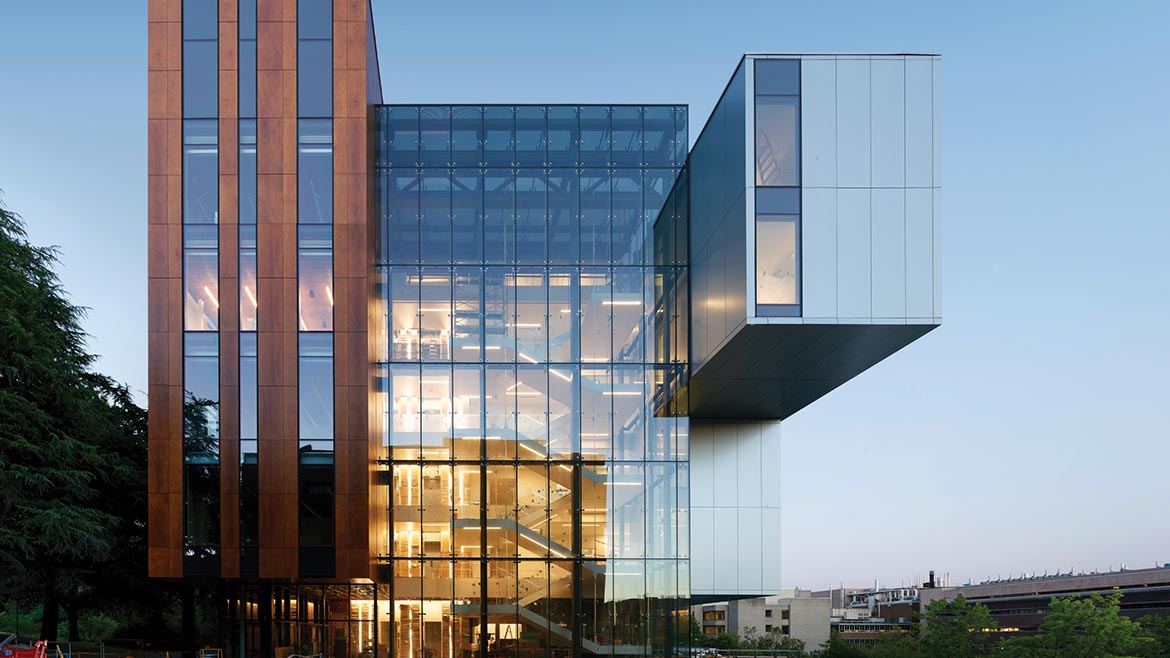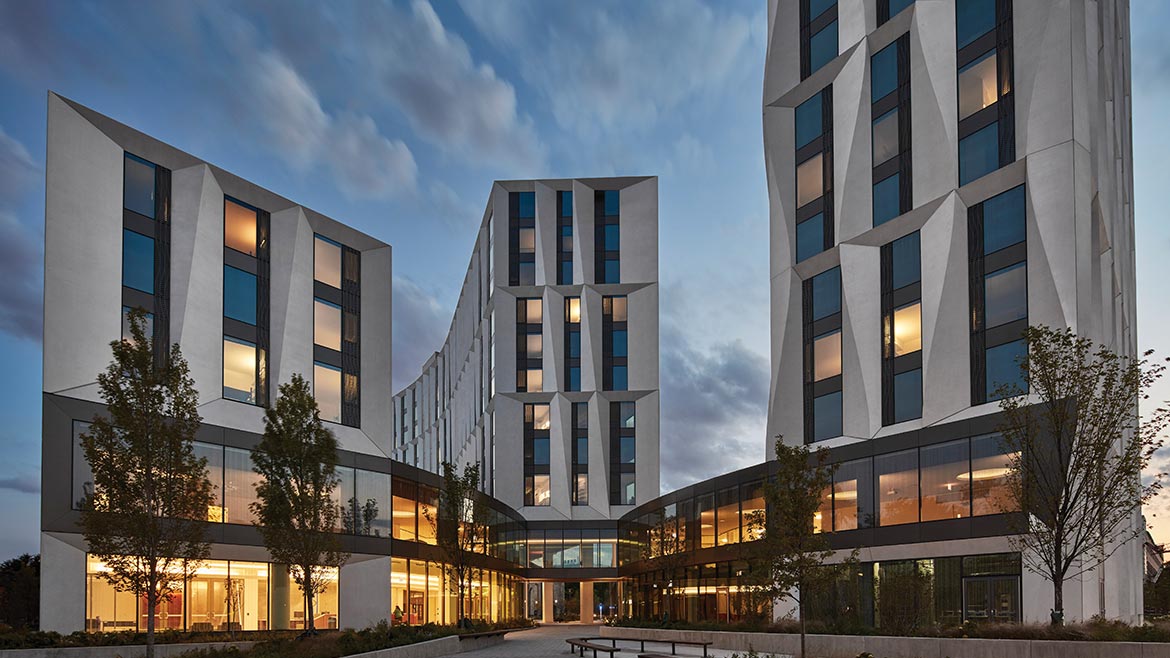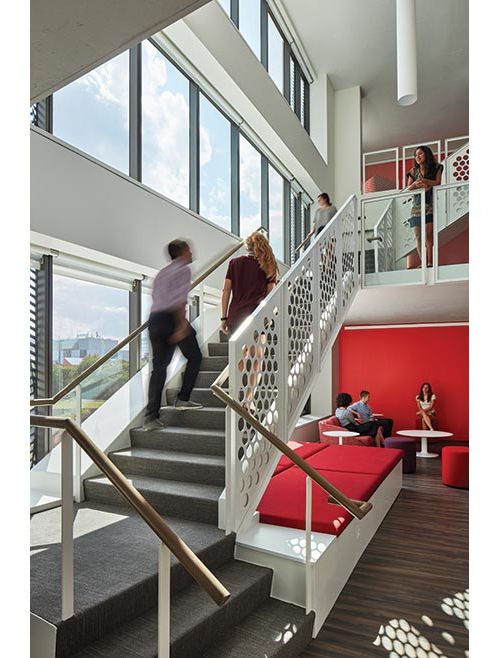Radiant Comfort Report 2023 Winter Edition
The underground movement toward radiant cooling and future-proof building
Best practices for incorporating radiant cooling systems.

Studio Gang Architects: University of Chicago Campus North Residence Commons, Chicago. Photos courtesy of REHAU
Radiant heating and cooling systems are not new to the North American market, but there’s a strong trend toward incorporating both, especially for tightly controlled environments such as commercial spaces.
"Architects and engineers who are familiar with radiant systems know that they are a great way to help reach zero-energy building targets such as LEED Zero certification," states Skip Daugherty, senior designer for REHAU. "In the past, radiant was the hip new thing that added comfort and energy efficiency. You could heat or cool a space with high ceilings and melt the snow on the sidewalk as well. With the impacts of extreme weather conditions and demand for more sustainable solutions, more specifiers are turning to radiant systems to help future-proof buildings and achieve environmental certifications."
"A radiant heating and cooling system is a great delivery method for using less energy to heat and cool," adds Johnny Modica, technical project specialist for REHAU. Studies by building technology experts, including DOE and UC Berkeley’s Center for the Built Environment, recommend radiant cooling as the technology with greatest potential for energy savings at competitive or reduced investment costs.

To help the University of Washington achieve greenhouse gas emission goals for the building, Seattle-based engineers Fareez Ismail and Martin de Vrieze at Affiliated Engineers specified a variety of energy-efficient technologies for the heating and cooling systems. Included are a chilled beam (“wave”) system by Barcol-Air USA, chilled sails, airside run-around (30 percent propylene glycol) heat recovery, natural ventilation and a radiant heating and cooling system by REHAU.
Beyond sustainability, technology is creating opportunities for radiant cooling
One of the common concerns about radiant cooling is that there is a risk of condensation, which can occur when the floors or ceilings of the system are below the dew point temperature of the space. Control of humidity and entering water temperature eliminates the potential for condensation. ASHRAE Standards 55 and 62.1 prevent the conditions that would allow condensation to form on radiantly cooled surfaces.
"Building control systems are able to monitor dew points and turn radiant cooling on and off as needed," explains Jeff Schneider, technical sales manager for REHAU. "These sophisticated condensation controls were not readily available or cost effective 20 years ago. Now everything is internet connected. Building operations systems can control everything — so it makes radiant heating and cooling easier to implement — giving better options to incorporate heating and cooling cost-effectively."
Despite technology advancements, the benefits of radiant cooling appear to be less known compared to radiant heating. "While radiant heating is prevalent in our design work at REHAU, especially in sustainable, LEED or Net Zero structures, radiant cooling is not as commonly incorporated due to a lack of comfort or understanding by engineers," Daugherty notes. "When engineers become familiar with the systems, they are more likely to use radiant cooling."

The University of Chicago Campus North Residential Commons feature student living quarters using REHAU in-slab hydronic radiant heating and cooling to improve energy efficiency and enhance comfort for the students.
The benefits of radiant cooling systems
-
Higher level of comfort. Circulating cool fluid from a chiller or heat pump through radiant panels actively lowers the surface temperatures in the room. This silently conditions a warm space, even if it has high ceilings, like an atrium. "My favorite thing is to bring the client to a nearby radiant job, and they immediately feel the comfort," Modica says. "You can walk to whatever corner of the room, and you don’t feel cold or hot spots. You don’t want to feel air — you want to feel comfort and that is what radiant heating and cooling delivers."
-
Sustainable efficiency. Radiant cooling provides a comfortable environment by optimizing the surface temperature of the occupants’ surroundings and efficiently absorbing unwanted heat from the space. By surrounding occupants with cooled surfaces, radiant cooling allows the thermostat to be set a few degrees higher.
According to a 2017 New Buildings Institute research study that explored the energy performance of commercial buildings with radiant heating and cooling, radiant buildings are more energy efficient than 90% of comparable buildings, with two-thirds receiving an ENERGY STAR score of 90 or above.
"It takes a lot of energy to move air around a building," Daugherty says. "Radiant helps a forced air system to achieve a building’s load needs. Used in combination, the forced air system can be smaller overall due to the shared load."
-
Occupant health. Radiant systems operate silently and generate less noise than forced air fans which can circulate dust and air pollutants if left unfiltered. However, when combined with forced air, the system is often used to bring in fresh ventilated/filtered air, reduce humidity and can be adjusted more quickly as needed to enhance comfort and air quality throughout the building.
The University of Chicago Campus North Residence Commons features common areas heated via a traditional forced air system, while the student living quarters use REHAU in-slab hydronic radiant heating and cooling. Todd Zima, design principal at Studio Gang, says the radiant heating and cooling system was chosen early in the project for the dorm rooms in order to improve energy efficiency and enhance comfort for the students. By circulating heated or chilled water through 5/8-inch REHAU RAUPEX PEXa pipe installed in the ceilings on each floor, the hydronic system maintains the spaces at even, comfortable temperatures while using less energy than traditional forced air systems.
Best practices for incorporating radiant cooling

In addition to dorm rooms, some common areas of the University of Chicago residence hall complex, including this multistory space, are heated and cooled with REHAU radiant technology.
-
Hybrid systems. Incorporate a "hybrid" system that pairs radiant cooling inside the building with a Dedicated Outdoor Air System (DOAS). This method decouples sensible and latent loads, allowing the key variables that optimize comfort and energy efficiency to be independently and precisely controlled.
Radiant cooling can be used in conjunction with radiant heating systems, utilizing the same network of REHAU RAUPEX pipe, embedded in a surface. For ultimate efficiency, high-performance buildings couple radiant cooling with geoexchange systems that bring consistently cool water from underground without full reliance on a chiller.
-
Plan early to add cooling. "Radiant applications are sometimes an afterthought, but since they are often incorporated into a building’s structural floor, they must be planned for in the early stages of the design process," Daugherty says. "In addition, radiant cooling applications will often require a higher pipe concentration (tighter pipe spacing) compared to heating-only systems. Since both the heating and cooling systems typically use the same PEX circuits, the radiant design needs to be considered early on to avoid issues with sizing other building systems and components."
-
Hard surfaces are most effective for radiant. The R-value determines whether a flooring material will help or hinder a building’s ability to resist heat loss and gain. "The R-value of flooring plays a role in designing radiant systems," Schneider says. "For instance, we do not recommend carpets and pads for cooling. The best surfaces are tile, stone, LVT (luxury vinyl tile) and concrete. While most wood floors are okay for heating, they are not good materials for radiant cooling." The type of flooring in a space can impact the effectiveness of the system, so it should be a consideration in the design of the system.
-
Taking the first step. "Radiant cooling requires folks to wrap their heads around it," Schneider explains. "Engineers and designers have to dive in and take the time to learn about it. Everyone is chasing Net Zero, and this is one of the tools that helps buildings achieve it."
"The biggest thing is to analyze the project and find the right combination of applications to best meet the building’s needs," Modica adds. "That’s the fun part of educating our customers about radiant. With radiant applications, you work with what you have and look to complement it. The system is designed around the client’s temperature set points, humidity levels, climate, flooring, ceilings, ventilation, etc. Engineers need to be asking the questions and reaching out to manufacturers to partner and learn about new ways of heating and cooling for their client’s comfort, the longevity of the building and the environment. The first step or project is important because it builds the expertise that other engineers are already establishing."
Looking for a reprint of this article?
From high-res PDFs to custom plaques, order your copy today!








